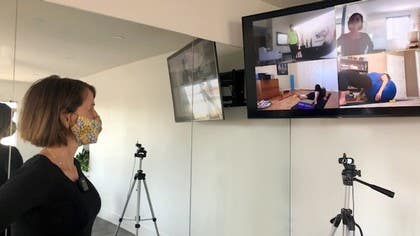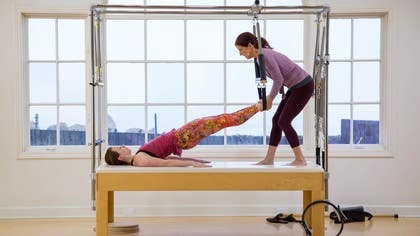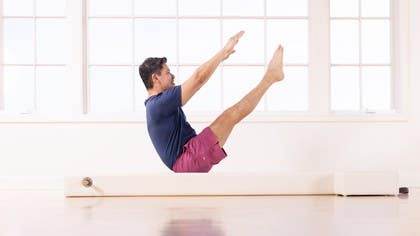
Part Three of Our "State of the Pilates Industry" Survey: Studio Owners
Prior blog posts looked at various segments of the industry. Our first piece focused on the Pilates enthusiast or participant (not professionals). The second piece looked at the experience of instructors. In this post, our final piece, we’re looking at how the landscape has shifted for Pilates studio owners (both traditional studios offering privates, duets, and semi-private sessions and those offering group Reformer classes).
We’ll also include insights from a recent conversation between John Marston and Gia Calhoun of Pilates Anytime, which was part of our Pilates Report series that looks at issues of interest to Pilates professionals. Read on to learn more about our findings and our predictions as we all navigate a new normal thanks to Covid-19.
“The Genie is Out of the Bottle”
Nearly two years into the global pandemic, many of us are accustomed to working--and working out--from home. The Pilates industry collectively learned to Zoom, since the only options in some places were to close their studio doors or pivot to remote instruction or video-on-demand. Clients have discovered the convenience of working out at home, often purchasing equipment like Reformers. They may be working out more often, not less, now that the Reformer is only a few yards away from their bed or desk.
Of more than 1500 survey respondents, nearly one fifth, or 18 percent, identified as Pilates studio owners. Prior to the pandemic, 90 percent of these studios offered private sessions on equipment, as well as duets and semi-privates (77 percent), and group classes (65 percent). Nearly 15 percent of studio owners also ran teacher training programs, an important source of both revenue and future teaching talent. Nearly 40 percent of respondents had owned their studio for five years or less (38 percent), with another 23 percent having owned their studio for ten years, and 8.5 percent for 20 years or more. Not surprisingly, only one of our respondents opened a studio during the pandemic.
The Studio Model Under Pressure
During the pandemic, individual instructors lost work when studios closed or had limited access, but in some cases they recouped their clients and income by teaching on Zoom, often cutting out the studios in the process. In the old days, client contact information was “owned” by the studio, but since the text message has replaced the studio receptionist in many cases, instructors were now free to make their own arrangements with clients.
This development, together with lockdowns, the reality that exercising in a mask is not comfortable for most people, and general squeamishness about exercising in close proximity to others during a global pandemic, likely contributed to studio revenue decreasing for 80 percent of our respondents. Fourteen percent of studio owners reported that their business remained about the same, while another seven percent actually saw an increase in business during Covid.
One third of our respondents said that the number of studios in their community had decreased during Covid. Nearly a quarter of studio owners in our survey had to permanently close their own studios. Unlike individual instructors, this group had the extra burden of having to pay rent, utilities, and insurance. They also had made investments in equipment that was often just gathering dust (though nearly 20 percent of studio owners in our survey reported renting their under-used Pilates equipment to their clients when their studios were idle).
During the pandemic, three-quarters of studio owners in our survey transitioned to online platforms such as Zoom. Fourteen percent moved their classes or equipment outdoors (no small feat in a cold climate!). Thirty-six percent continued to teach in person.
Screen to Screen, Not Face to Face
Teacher training also went virtual, by necessity. The jury is still out on the value of virtual teacher training in the Zoom era, as tactile cueing is a cornerstone of good Pilates teaching. In addition, most trainees lack access to the traditional Pilates apparatuses if the teacher training is not based at a physical studio.
Pilates conferences also shifted to virtual. One positive aspect is that teachers and studio owners didn’t need to block out a long weekend to attend a conference in a far-away city or even country and pay for food, lodging, and transportation in addition to conference fees. We saw bite-sized, in-town retreats and conferences spring up during the pandemic to take the place of larger and longer gatherings.
The pandemic ushered in social isolation that, for some, led to introspection. People are asking themselves questions like, “What do I want my life to look like?” and “Where do I want to live?” To some, the answers may include leaving the Pilates industry. Especially at the beginning of the pandemic, instructors may have felt pressure (economic and social) to continue to teach in-person, particularly if they cater to a higher-end client who is used to having services performed at home. Some instructors, especially those whose age makes them more vulnerable to the virus, may have decided it wasn’t worth the risk. Our respondents indicated that nearly 16 percent of their instructors chose to leave during the pandemic, while another six percent were laid off.
Of the 66 studio owners who reported that they had closed their studios, slightly more than 71 percent (47) are still teaching. Six studio owners (nine percent) are pursuing another career, while only one (1.5 percent) has retired. More than a quarter of owners, however, said they had downsized their studios, perhaps by subleasing space to an affiliated business, moving to a space with a smaller footprint, or shifting to a home studio.
Survival of the Nimblest
Vaccine hesitancy, coupled with slow vaccine rollouts, continues to cause spikes in cases, as well as leading to variants and further lockdowns. The result is that a hybrid workout regimen appears likely to stay, with 56 percent of studio owners citing this model as the one they expect to see going forwards. This model includes traditional sessions at a studio with an instructor, but supplemented with home workouts, either with video-on-demand or a Zoom instructor, or perhaps outdoors at a park or in a parking lot. Thirty percent of owners intend to offer in-person classes and sessions only. One-third expect to see an uptick in demand for duets and semi-private sessions, perhaps reflecting that larger group classes are less appealing right now.
Looking ahead, we expect that the studios that will remain in business are those that can be nimble, adaptable, and flexible. How are you managing during this time, and what changes have you made to your business due to Covid? Let us know in the comments below.
Comments
No comments yet. Be the first!













You need to be a subscriber to post a comment.
Please Log In or Create an Account to start your free trial.